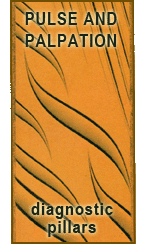Archive for the ‘Pulse Class’ Category
The Moderate, Slowed-down, Lax, Retarded, Leisurely Pulse (Huan Mai)

Moderate Pulse (緩脈 Huan Mai, slowed-down, lax, retarded, leisurely)Key points: feels slow to the fingers, but normal by the clock. Indications: Dampness: sticky substance impedes flow of qi and blood in vessels.
 Last modified: August 7, 2009 ·
Last modified: August 7, 2009 ·  al ·
al ·  No Comments
No Comments
 Tags: Diagnosis, Palpation · Posted in: Pulse Class, Pulse-Palpation
Tags: Diagnosis, Palpation · Posted in: Pulse Class, Pulse-Palpation
The Rapid Pulse (Shuo Mai)

Rapid Pulse (90-140 bpm) (數脈 Shuo Mai) key point: fast. Indications: (Forceful) Excess heat: excessive heat stimulates the circulation of the qi and blood.
 Last modified: August 6, 2009 ·
Last modified: August 6, 2009 ·  al ·
al ·  No Comments
No Comments
 Tags: Diagnosis, Palpation · Posted in: Pulse Class, Pulse-Palpation
Tags: Diagnosis, Palpation · Posted in: Pulse Class, Pulse-Palpation
The Racing, Hurried, Urgent, Swift Pulse (Ji Mai)

Racing Pulse (疾脈 Ji Mai, hurried, urgent, swift) key point: extremely rapid (over 140 bpm) Indications: (Forceful) Excess heat: heat excites movement of blood leading to the rapid pulse.
 Last modified: August 5, 2009 ·
Last modified: August 5, 2009 ·  al ·
al ·  No Comments
No Comments
 Tags: Diagnosis, Palpation · Posted in: Pulse Class, Pulse-Palpation
Tags: Diagnosis, Palpation · Posted in: Pulse Class, Pulse-Palpation
The Consistently Irregular, intermittent, or regularly intermittent pulse (Dai Mai)

Consistently Irregular Pulse (代脈 Dai Mai, intermittent, regularly intermittent) Key points: regularly missed beats Indications: (Rapid) Wind, pain, emotional shock: pathogenic factors cause qi stagnation leading to intermittent pauses in the pulse.
 Last modified: August 4, 2009 ·
Last modified: August 4, 2009 ·  al ·
al ·  No Comments
No Comments
 Tags: Diagnosis, Palpation · Posted in: Pulse Class, Pulse-Palpation
Tags: Diagnosis, Palpation · Posted in: Pulse Class, Pulse-Palpation
The Rapid Irregular, Hasty, Abrupt, Skipping Pulse (Cu Mai)

Rapid Irregular Pulse (促脈 Cu Mai, hasty, abrupt, skipping) Key points: rapid with irregular pauses. Indications: (Forceful) excess heat (causing stagnation), or stagnation (generating heat.
 Last modified: August 3, 2009 ·
Last modified: August 3, 2009 ·  al ·
al ·  No Comments
No Comments
 Tags: Diagnosis, Palpation · Posted in: Pulse Class, Pulse-Palpation
Tags: Diagnosis, Palpation · Posted in: Pulse Class, Pulse-Palpation
The Slow Irregular, Knotted, Bound Pulse (Jie Mai)

Slow Irregular Pulse (結脈 Jie Mai, knotted, bound) Key points: slow with irregular pauses. Indications: (forceful) Stagnation, cold, tumor or masses: pathogenic factors stagnate within the vessels, block blood circulation.
 Last modified: August 2, 2009 ·
Last modified: August 2, 2009 ·  al ·
al ·  No Comments
No Comments
 Tags: Diagnosis, Practitioners · Posted in: Pulse Class, Pulse-Palpation
Tags: Diagnosis, Practitioners · Posted in: Pulse Class, Pulse-Palpation
The Deficient, Empty, Vacuous Pulse (Xu Mai)

Deficient Pulse (虛脈 Xu Mai, empty, vacuous) Key points: forceless at all three levels, can be wide.
 Last modified: August 1, 2009 ·
Last modified: August 1, 2009 ·  al ·
al ·  No Comments
No Comments
 Tags: Diagnosis, Palpation · Posted in: Pulse Class, Pulse-Palpation
Tags: Diagnosis, Palpation · Posted in: Pulse Class, Pulse-Palpation
The Excessive, Full, Replete Pulse (Shi Mai)

Excessive Pulse (實脈 Shi Mai, full, replete) Key points: long, wide, forceful on all three depths. Indications: pathogenic factors with strong anti-pathogenic qi: excess condition causes excess pulse.
 Last modified: July 31, 2009 ·
Last modified: July 31, 2009 ·  al ·
al ·  No Comments
No Comments
 Tags: Diagnosis, Palpation · Posted in: Pulse Class, Pulse-Palpation
Tags: Diagnosis, Palpation · Posted in: Pulse Class, Pulse-Palpation
The Flooding, Surging, Overflowing Pulse (Hong Mai)

Flooding Pulse (?? Hong Mai, surging, overflowing) Key points: forceful, wide, comes stronger than going Indications: qi level heat (wen bing, four levels), yang ming jing bing (Shang Han Lun), or Lung and Stomach heat (zang fu). All three of these pathologies are describing the same presentation.
 Last modified: July 30, 2009 ·
Last modified: July 30, 2009 ·  al ·
al ·  No Comments
No Comments
 Tags: Diagnosis, Palpation · Posted in: Pulse Class, Pulse-Palpation
Tags: Diagnosis, Palpation · Posted in: Pulse Class, Pulse-Palpation
The Large, Big Pulse (Da Mai)

Large Pulse (Big, 大脈 Da Mai) key point: wide. Indications: (forceful) excess heat: heat causes blood and qi to move more quickly and dilates blood vessels.
 Last modified: July 29, 2009 ·
Last modified: July 29, 2009 ·  al ·
al ·  No Comments
No Comments
 Posted in: Pulse Class, Pulse-Palpation
Posted in: Pulse Class, Pulse-Palpation
